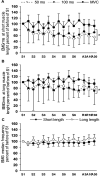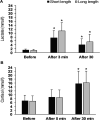High-volume intermittent maximal intensity isometric exercise caused great stress, although central motor fatigue did not occur
- PMID: 34475614
- PMCID: PMC8329970
- DOI: 10.5114/biolsport.2021.99322
High-volume intermittent maximal intensity isometric exercise caused great stress, although central motor fatigue did not occur
Abstract
To establish whether very high-volume, high-intensity isometric exercise causes stress to the body and how it affects peripheral and central fatigue. Nineteen physically active healthy male subjects (21.2 ± 1.7 years; height - 1.82 ± 0.41 m, body weight - 79.9 ± 4.5 kg; body mass index - 24.3 ± 2.1 kg/m2) volunteered to participate in this study. They participated in two experiments 3-5 days apart. Each experiment comprised six series of 60-s maximum voluntary contraction (MVC) force (knee extension) achieved as rapidly as possible. This very high-volume, high-intensity exercise (HVHIE) was performed at different quadriceps muscle lengths: short (SL) and long (LL). The MVC and the electrically stimulated contractile properties of the muscle were measured prior to HVHIE, immediately after and 3 min after each series, and at 3, 10, and 30 min after the end of HVHIE. We found that HVHIE caused high levels of stress (cortisol levels approximately doubled, heart rate and the root mean square successive difference of interval (RMSSD) decreased by about 75%); lactate increased to 8-11 mmol/L, voluntary and 100 Hz stimulation-induced force (recorded immediately after HVHIE) decreased by 55% at LL and 40% at SL. However, the central activation ratio during MVC did not change after either exercise. Isometric HVHIE performed using one leg caused high levels of stress (RMSSD decreased, cortisol increased after HVHIE equally at SL and LL; La increased more while exercising at LL) and the voluntary and electrostimulation-induced muscle force significantly decreased, but muscle central activation during MVC did not decrease.
Keywords: High-intensity isometric exercise; High-volume; Muscle length; Peripheral and central fatigue; Physiological stress; Rate of force development.
Copyright © Biology of Sport 2021.
Conflict of interest statement
The authors certify that there is no conflict of interest with any financial organization regarding the material discussed in the manuscript.
Figures







References
-
- Bishop DJ, Botella J, Genders AJ, Lee MJ, Saner NJ, Kuang J. High-intensity exercise and mitochondrial biogenesis: current controversies and future research directions. Physiology (Bethesda) 2019;34(1):56–70. - PubMed
-
- Skurvydas A, Zachovajevas P. Is post-tetanic potentiation, low frequency fatigue (LFF) and pre-contractile depression (PCD) coexistent in intermittent isometric exercises of maximal intensity? Acta Physiol Scand. 1998;164:127–133. - PubMed
-
- Brazaitis M, Skurvydas A, Pukenas K, Daniuseviciute L, Mickeviciene D, Solianik R. The effect of temperature on amount and structure of motor variability during 2-minute maximum voluntary contraction. Muscle Nerve. 2012;46:799–809. - PubMed
LinkOut - more resources
Full Text Sources
